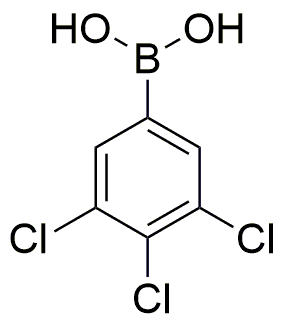3,4,5-Trichlorophenylboronic acid is widely utilized in research focused on:
- Organic Synthesis: This compound serves as a key intermediate in the synthesis of various pharmaceuticals and agrochemicals, allowing researchers to create complex molecules efficiently.
- Bioconjugation: It is used in bioconjugation reactions, where it helps attach biomolecules to surfaces or other molecules, enhancing the development of targeted drug delivery systems.
- Sensor Development: The compound is employed in the fabrication of chemical sensors, particularly for detecting phenolic compounds, which is crucial in environmental monitoring and safety assessments.
- Material Science: It plays a role in the development of advanced materials, such as polymers and coatings, that require specific chemical properties for improved performance in various applications.
- Medicinal Chemistry: Researchers leverage its unique properties to design and optimize new therapeutic agents, particularly in cancer research, where targeted treatments are essential.
General Information
Properties
Safety and Regulations
Applications
3,4,5-Trichlorophenylboronic acid is widely utilized in research focused on:
- Organic Synthesis: This compound serves as a key intermediate in the synthesis of various pharmaceuticals and agrochemicals, allowing researchers to create complex molecules efficiently.
- Bioconjugation: It is used in bioconjugation reactions, where it helps attach biomolecules to surfaces or other molecules, enhancing the development of targeted drug delivery systems.
- Sensor Development: The compound is employed in the fabrication of chemical sensors, particularly for detecting phenolic compounds, which is crucial in environmental monitoring and safety assessments.
- Material Science: It plays a role in the development of advanced materials, such as polymers and coatings, that require specific chemical properties for improved performance in various applications.
- Medicinal Chemistry: Researchers leverage its unique properties to design and optimize new therapeutic agents, particularly in cancer research, where targeted treatments are essential.
Documents
Safety Data Sheets (SDS)
The SDS provides comprehensive safety information on handling, storage, and disposal of the product.
Product Specification (PS)
The PS provides a comprehensive breakdown of the product’s properties, including chemical composition, physical state, purity, and storage requirements. It also details acceptable quality ranges and the product's intended applications.
Certificates of Analysis (COA)
Search for Certificates of Analysis (COA) by entering the products Lot Number. Lot and Batch Numbers can be found on a product’s label following the words ‘Lot’ or ‘Batch’.
*Catalog Number
*Lot Number
Certificates Of Origin (COO)
This COO confirms the country where the product was manufactured, and also details the materials and components used in it and whether it is derived from natural, synthetic, or other specific sources. This certificate may be required for customs, trade, and regulatory compliance.
*Catalog Number
*Lot Number
Safety Data Sheets (SDS)
The SDS provides comprehensive safety information on handling, storage, and disposal of the product.
DownloadProduct Specification (PS)
The PS provides a comprehensive breakdown of the product’s properties, including chemical composition, physical state, purity, and storage requirements. It also details acceptable quality ranges and the product's intended applications.
DownloadCertificates of Analysis (COA)
Search for Certificates of Analysis (COA) by entering the products Lot Number. Lot and Batch Numbers can be found on a product’s label following the words ‘Lot’ or ‘Batch’.
*Catalog Number
*Lot Number
Certificates Of Origin (COO)
This COO confirms the country where the product was manufactured, and also details the materials and components used in it and whether it is derived from natural, synthetic, or other specific sources. This certificate may be required for customs, trade, and regulatory compliance.


